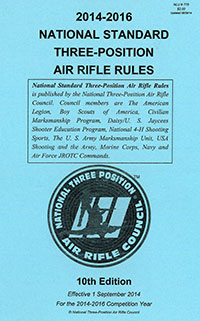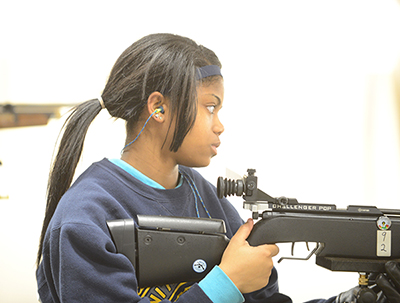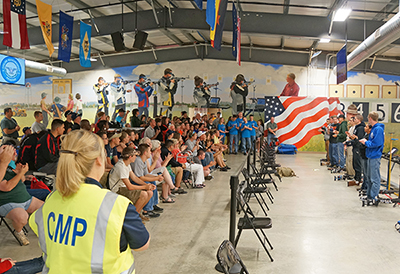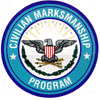The 10th edition 2014-2016 National Standard Three-Position Air Rifle Rules, with an effective date of 1 September 2014,has just been released. The National Three-Position Air Rifle Council, the governing body for almost all three-position air rifle competitions in the USA, issues new “National Standard Rules” every two years. Council members include The American Legion; the Army, Marine Corps, Navy and Air Force JROTC Commands; BSA; CMP; Crosman Shooting Services; the Daisy Shooter Education Program; 4-H Shooting Sports and USA Shooting.
 |
|
The new 2014-2016 National Standard Three-Position Air
Rifle Rules have just been released. Copies of the
rules can be downloaded at
http://publ.com/BUSpRxp.
|
The new rules can be downloaded from the CMP website at http://publ.com/BUSpRxp. Coaches and athletes are encouraged to download and study the rules as soon as possible so that they can be up to date on the latest changes.
After introducing a series of major changes two years ago, there are very few changes in this year’s rulebook. The 2012 changes in the course of fire, with separate preparation and sighting periods before record firing, as well as changes in finals procedures, proved to be successful changes that did not necessitate further changes this year. The updating of precision class clothing rules were implemented without forcing any athletes or clubs to buy new clothing that they did not intend to buy anyway. Changes in the finals rules made the flow and presentation of finals smoother and more interesting, especially for spectators.
Here is a summary of the 2014-2016 rule changes:
Rule 1.7 National Jury of Appeal
The National Jury of Appeal is a three-person judicatory body elected annually by the Council. The Council is comprised of three of the foremost experts on 3-position air rifle shooting in the USA. 2014 rule changes increased the National Jury’s scope of responsibility and strengthened its authority.
Rule 2.14 Safety Rule Violations
This change clarified when a person can be disqualified for safety violations; disqualification is warranted when an athlete handles a gun so as to “endanger the safety of another person.”
Rule 3.2 Team Restrictions
The statement of intent regarding restrictions on teams was redrafted to emphasize that these restrictions are intended to promote the development of strong local club and school teams and to prevent the formation of “all-star teams.” The Council believes that a strong national shooting sports discipline can only be built on a foundation of strong local club and school teams and that allowing all-star teams to cherry-pick the best athletes from two or more local clubs or teams only weakens those teams.
Rule 3.2.3 Geographic Proximity Rule for Teams
The requirement that team members must live within the geographic proximity of the club or school remains unchanged, but the new rules establish a 75-mile zone around the team’s home base with a requirement that teams with potential members who live outside of that zone must submit a 75-mile waiver request that will allow these situations to be reviewed. The Council recognizes that there are legitimate reasons for allowing long distance travel for some team members (no local junior club; local club has no precision team, etc.). Too many times in the past, unfortunately, these situations did not come up until a protest was filed, often at a match. A fillable form will be provided on the CMP website to make submitting a request for a 75-mile waiver easy.
Rule 3.2.4 Regular Participation Rule for Teams
The rules have always required that team members must participate regularly in club or team activities regardless of their travel distance, but the new rules add emphasis to this by defining team activities as including “training sessions or club meetings.”
Rule 4.2.1, a Approved Sporter Air Rifles
The CZ 200T was added to the approved Sporter air rifle list. Champions Choice sells this rifle as the Champions Choice T200. The Council confirmed with Champions Choice that this rifle is available to clubs at the $525 maximum price through special purchase arrangements.
 |
| Athletes that use Sporter Class air rifles with adjustable cheek-pieces and butt-plates can now adjust them between positions. |
Rule 4.2.4, c & e Adjustable Cheek-Pieces and Butt-Plates
Adjustable cheek-pieces and butt-plates that are common on most Sporter Class air rifles today can now be adjusted between positions.
Rule 4.3.1, d Sporter Clothing Manipulation
The rules previously prohibited the rolling or twisting of Sporter clothing to provide additional support, but some tried to get around this rule. The new rule is more specific in saying that doing this to provide extra layers of support for the support arm in standing is strictly illegal.
Rules 4.3.2/4.6.4 Footwear for Shooting
Sporter athletes must wear regular low-cut shoes or sport shoes in all positions. Precision athletes must wear special shooting shoes or sport shoes in all positions. No competitors are permitted to shoot in sandals, stocking feet or bare-footed. The fundamental reason for this change is hygienic; range floors around the shooting positions accumulate lead deposits and dirt.
Rule 4.3.7 Taping
Any type of taping that is done to gain support or add rigidity to joints or stability to muscle groups is illegal. Post-competition testing may be used to check whether athletes are doing this.
Rule 4.4.1 Weights in Precision Air Rifle Butt-Stocks
Many questions have arisen in the last two years regarding what exactly is meant by “weights (in the butt-stock) must be within the dimensions of the stock.” International equipment control experts have now decided that the only basis for controlling this is to use the 40 mm maximum distance from the centerline of the bore allowed for cheek-piece extensions as the same maximum extension for butt-stock weights. A possible spread of 80 mm is a long ways, but at least there is now a standard.
Rules 4.7.2/5.1.3, h Kneeling Roll Placement.
A controversy arose during the 2014 summer championships regarding whether an athlete can place the kneeling roll under the lower leg instead of under the area of the ankle. The new rules stipulate that the kneeling roll must be in contact with some part of the area of the ankle and not under the shin.
Rule 4.7.4 Rifle Stands with Rifle Cradles (Hooks)
Many athletes are now using rifle stands with hooks to hold the rifle when it is not being held in a firing position. Unfortunately, some hooks were placed high enough to unbalance the stand and make it easy for a slight bump to tip them over and damage the rifle. A new “advisory” rule encourages the placement of these hooks low enough to make the stands more stable.
Rule 5.1.2, f Standing Position
The new rules clarify that in standing, the right hand, as it grasps the pistol grip, may not touch or hold the shooting jacket.
Rule 5.1.4 Athletes with Impairments
The Council is striving to find fair and effective ways to allow athletes with impairments or disabilities to compete for awards in regular competition. The Council also believes that when athletes with impairments compete, they should do so by using International Paralympic Committee (IPC) athlete classifications, firing positions and adaptive systems. Rule changes in 2012 opened the way for athletes with IPC SH1 type impairments to compete for awards in regular competitions. SH1 athletes generally have good upper body control and full use of both arms. Athletes with SH2 type impairments have more limited upper body control and do not have full use of both arms. Under IPC Rules, they are allowed to place the rifle on a flexible support stand that still requires the athlete to provide some stability to the rifle. The challenge with including SH2 type athletes in regular competitions is that scores fired with SH2 adaptations tend to be much higher than 3-position scores fired by able-bodied athletes. The Council is working on developing a “compensating factor” that could allow these athletes to compete in regular competitions. The rules for athletes with impairments will continue to be experimental and changing with an ultimate goal of mainstreaming as many of these athletes as possible. Any club or school that has an athlete with impairments who wants to compete is urged to contact the Council at 3PAR@TheCMP.org to begin a dialogue about how this young person can become active in shooting.
Rule 5.3.1, g Provisional Use of Decimal (10th ring) Scoring
The Council will continue to use whole number scoring for all of its Championships and CMP Cup Matches except, of course, for the use of decimal scoring in finals. However, since the ISSF changed to decimal scoring for 10m Air Rifle and 50m Rifle Prone events, some match sponsors with electronic (Orion or EST) scoring now use decimal scoring for some matches as a way to let young shooters gain experience with the new international standard. The 2014-2016 Rules simply recognize that match sponsors that want to do this can do so on a provisional basis.
Rule 7.15 Interruption Procedures
The Rules clarified that additional sighters are not allowed for interruptions that last less than five minutes. Additional sighters are allowed for longer interruptions or for interruptions that require an athlete to be moved or resquadded. If an interruption lasting longer than five minutes occurs after the five-minute warning, two minutes of additional time must be given. Two minutes of extra time must always be given if the athlete must be moved or resquadded.
Rule 7.16.1 Malfunction Procedures
The malfunction rule was modified so Range Officers can allow the replacement of a malfunctioning rifle without having to find “physical evidence of the malfunction.” Two minutes of extra time will now be given if a malfunction or rifle replacement occurs after the five-minute warning.
Rule 9.1 Protest of Competition Conditions
Time limit in which protests to the competition jury can be submitted changed from 1 hour after end of competition to 30 minutes of the decision or action being protested.
Rule 10.3.4 Finals LOAD and Shot Times
The finals rules adopted in 2012 remain unchanged except that the delay after the LOAD command was changed from ten to five seconds and the firing time after the START command was changed from 45 to 50 seconds. This change coordinates 3-position rules with ISSF Rules and ensures that athletes who also compete in USA Shooting competitions do not have to change between two different finals systems.
 |
| Rules for the conduct of 3-position finals remain unchanged from the 2012-2014 Rules except for changing the LOAD command delay from 10 to 5 seconds and the shot time from 45 to 50 seconds. |
Rule 10.0 Finals
Except for the change noted above, the Council decided not to change the 3-position finals rules. However, the new finals rules adopted by the ISSF in 2013 with start-from-zero scoring, eliminations during the final and greater numbers of shots (20 in one position finals; 45 in 3-position finals) have stimulated interest among some clubs that want to try these new finals. The new rules allow match sponsors to use the new ISSF Finals Rules on a provisional basis.
Rule 11.4 National Records
The rules clarify that National Records can only be shot in shoulder-to-shoulder matches (no postal scores).
JUNIOR EIC AWARD PROGRAM
In 2012, several changes were made to the criteria for earning EIC points that count towards the awarding of the Junior Distinguished Badge. The biggest change was the introduction of minimum qualifying scores. These changes have worked well and no further changes were made in those requirements this year.
Anyone with questions about the 2014-2016 National Standard Three-Position Air Rifle Rules or who wants further information should contact 3PAR@TheCMP.org.
NEXT ARTICLE
| 
